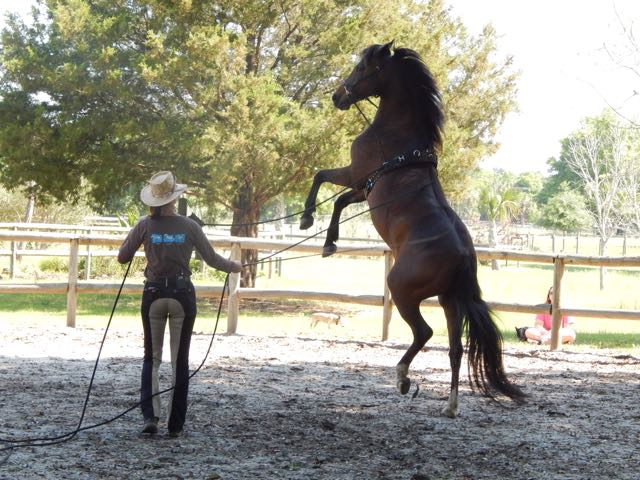QUESTION from a student: I have a 6 yr old horse who never was really in front of the leg, but now she gets sticky, refuses to go into trot, will spook, and will stop and rear if I escalate things. Someone on the ground with a lunge whip helps, but I can't do that forever! On line she will also stop and rear, but then settles in. When she IS going, she can be great. She will trot and canter from the slightest squeeze, does lateral work, will stretch and can be ridden on a long rein or in soft connection. I have tried her with different saddles and different riders of different weights, and have had her checked by a vet, and all is OK. What can I do? Please help!
ANSWER: It sounds like you have investigated a lot of things (pain, saddle, the human that is on top of her... etc). It's smart to get the vet out and especially look for ulcers, kissing spine, etc. As always, we want to address the root cause of the behavior. Sometimes it is health, sometimes it is caused by us (our own tension and choices), and sometimes it is a behavior issue. Some horses only rear when under a lot of stress or discomfort, and some rear as an easy reaction to small things. We always need to investigate and take our best guess about why, what they are thinking, what they are disliking, and either remedy it, or prove to them that things will be easier than they think they will be. It requires a combination of having an attitude of helping, surgical firmness, relaxation, and a lot of making it a good deal for them.
My answers will assume health issues are investigated, and you have reflected to make sure the training choices have not caused confusion, stress etc. Since when she does go you say she goes well, I would think that could be a clue that there is not actual physical discomfort. I'm always keeping an eagle eye out for: When the horse does what I ask, do they become more anxious, or uncomfortable looking or more relaxed and comfortable... And I pay attention to the next day. If you are able to have a good training session and the next day things improve, then it is likely a behavior issue that can be addressed with training. If the behavior gets worse the next day, then they may be defending themselves against pain, and you'll want to stop pushing and investigate further.
I actually have met three horses this year that have had a similar issue, and we were able to change the pattern in each one. One was a very dominant mare who would get fixated on a particular place in the arena, or with her buddy in the pasture and wanted to go there and stop and would rear/explode if pushed. It seemed like a behavior issue because it was location-dependent. She had strong preferences. Another was a gelding who was sometimes lovely, but would start to spook (at familiar objects), then get stuck, and another was a young horse just getting started, who has a genetic predisposition for this kind of behavior and would get stuck (no rearing, but some threat to rear).
The solution is two-fold

1. Communication In The Moment. Rearing is not safe behavior and we need to be able to interrupt it if we see it coming. Once they rear it's too late and you need to resist the temptation to punish it. When she starts to get stuck, see if you can offer an alternative thing to do. Get her moving somewhere, sometimes simply doing a small circle is all it takes.... A hind quarter yield anytime anywhere is helpful as it takes away their ability to be on their back feet. In the beginning, with one horse that was all we did, quietly checking them on each side until the horse said: "Can I please walk forward?!" YES, thank you!
Of course this comes from making sure this communication works well in the easier moments... Up your game and expectation as far as general responsiveness and communication in the good moments.... You might solve much of it between the pasture and the grooming stall... Look for clues or hints of the same behavior (getting sticky) everywhere and solve them there where you can be more sure that the horse is comfortable.
2. Make It Good For Them. Pay attention to what you ask them to do when they ARE going. Don't make them regret moving forward. They will just try harder to get out of it next time. What does this horse like to do? Does she feel safer and happier in the arena, or out in the open? With another horse? Doing some jumping? What can you do to help your horse enjoy the rides more in general so it isn't always work? Make the priority that when you ask, she goes... Then make it a big payoff... As if you are asking: "Would you go?" and when she does you say: "Oh, OK, thanks, I was just checking". Reward when you get a positive change. Don't be too greedy to ask for more once going.
It is tempting with these types to keep going once they are going, or to punish them. But I would tempt you to reward after good responses. Stop, maybe even get off, then start again and see. So in one session instead of addressing it only once, you will have multiple opportunities to prove that you are NOT going to ask too much. And stop when you get a significant improvement for that day... Don't keep pestering if it is better than the day before. It is so important to prove to these horses that you want them to enjoy their rides!
I recently helped a dressage rider with a horse who would just shut down like that and it drove her crazy to stop once she got going, but it really paid off. I rode with her and we took turns... she would ride and I would watch and help her, then she would hangout on her horse and watch me and help me with one of mine... if the horse even thought about rearing we did a HQ yield... she knew we would persist and she would change her mind. The behavior gradually melted away as we removed the reasons for her defensiveness.
With the baby who had the genetic pre-disposition for this behavior I was careful not to get too strong with her... I was more persistent rather than harder phases of aids.... I just hate showing horses how big a fight could get when they are so young.. Again, the behavior melted away. With the other horses (5 and 6 years old) they unfortunately had had some more practice at their pattern and it persisted a little longer but the moments became less frequent, and changed fairly quickly each time, so there were very brief moments of firmness followed by lots of reward. It improved, it just took consistent intention, persistence, and timing. The rider was very accomplished, but was a little fearful of them when they stopped, so it was more about staying relaxed and quietly non-negotiable.
Good news is these three horses I mentioned as examples are going really well... My young one just spent 2 months riding out and about learning that life is so easy and interesting when you cooperate and now she is allowing me to talk to her about things in the arena and she is forward nicely. The other 2 horses are also going really well. One is now jumping and he really loves that and has been a star! The other is going very well, but the rider must be super attentive on a daily basis that her attention is on her in all those little 'in-between moments'. If she has her attention and is able to interrupt the first thoughts and offer a different choice then she is also a star, but it takes a lot of focus.
So clarify the communication, gain their trust, and make it fun for them when they say yes!
With any persistent behavior it is good to look at the whole picture. The Happy Athlete Training Scale is a great model to use. You can read more about it here.



